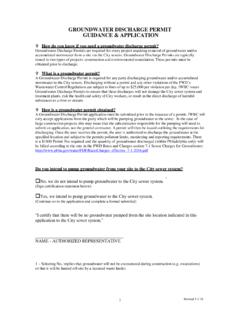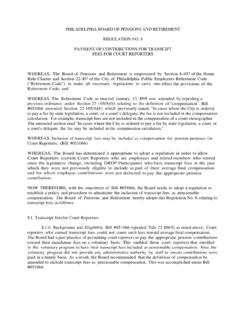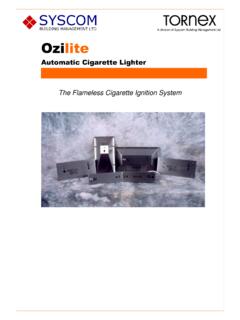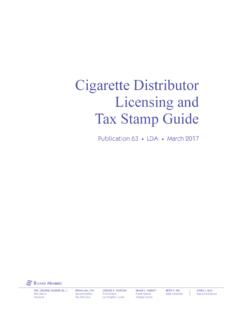Transcription of Electronic Cigarette Fact Sheet - Philadelphia
1 Philadelphia Department of Public Health July 2013 Page 1 of 4 Electronic Cigarette fact Sheet The availability, marketing, and use of Electronic cigarettes (or e- cigarettes ) are growing, as big tobacco companies increase their investments in these products. Because e- cigarettes are unregulated, limited information is available on their contents and health effects, leaving the public, health agencies, and retailers with many unanswered questions. This fact Sheet addresses some common areas of misunderstanding. However, to enable fully informed decision-making on e- cigarettes , more scientific research and federal regulation are needed. 1. What is an Electronic Cigarette ? Electronic cigarettes (e- cigarettes ) are a type of Electronic nicotine delivery system (ENDS), resembling cigarettes . ENDS can also look like pipes, pens, or USB memory sticks. They generally consist of three integrated parts: the cartridge which contains nicotine, the vaporizer, and a lithium ion battery.
2 The battery powers the vaporizer that heats the nicotine mixture in the cartridge that the user then inhales as a vapor. This is also known as vaping . There is usually an indicator light that mimics the burning end of a conventional Cigarette . E- cigarettes cost approximately $60, and refill cartridges cost $7-$ More recently, disposable e- cigarettes that last up to two packs are being sold for under $10. 2. What are the contents of an e- Cigarette ? Cartridges generally contain 20 mg of However, as e- cigarettes are unregulated by the Food and Drug Administration (FDA), their contents and the level of these contents can be highly variable. Early studies by the FDA found varying levels of nicotine and other potentially harmful ingredients, including cancer-causing substances and di-ethylene glycol, which is found in All the major tobacco companies are now producing Electronic cigarettes , and it is not yet clear if companies will modify these products like they did with cigarettes to maximize addictiveness.
3 3. Who is using e- cigarettes ? The awareness and use of Electronic cigarettes are increasing. In 2011, 6 of 10 adults were aware of Electronic cigarettes with 21% of smokers having used an Electronic Cigarette recently. This is Components of a typical Electronic Cigarette Image courtesy of The American Legacy Foundation Philadelphia Department of Public Health July 2013 Page 2 of 4 compared to 2010 when 4 out of 10 adults were aware and 10% of smokers had used an Electronic Cigarette recently. While Electronic Cigarette usage increased for all groups that were studied, including young adults, the sharpest increases were seen among those aged 45 54 years, non-Hispanic Whites, and both current and former 4. What are the health effects of e- Cigarette use? Limited independent research has been conducted into both short- and long-term health impacts of e- cigarettes . Adverse events related to e- cigarettes that were reported to the FDA include hospitalizations for pneumonia and heart failure, second degree burns, and a possible infant death from choking on a Short-term negative impacts on lung functions have also been In addition, acute nicotine administration increases heart rate, blood pressure, and impairs Based on the limited research available, e- cigarettes are likely to be substantially less harmful than traditional cigarettes .
4 Refill bottles for e- cigarettes contain up to 7 mg of nicotine, and the fatal dose of nicotine for children is 10 Therefore, there is concern about accidental ingestion by children in homes with e- Cigarette users. 5. Is secondhand e- Cigarette smoke or vapor harmful? Nicotine is found in both inhaled and exhaled vapor of Electronic One study found heavy metals and silicates, along with nicotine, in exhaled e- Cigarette Use of e- cigarettes in indoor spaces can also create confusion about smoke-free policies, as they closely resemble the act of smoking cigarettes . Some state and local health departments have included e- cigarettes in indoor smoke-free laws. 6. Are smokers using e- cigarettes to try to quit? And are e- cigarettes effective in helping people quit? The most common reasons for using e- cigarettes as stated by consumers are to help with cravings, to use less toxic alternatives to regular cigarettes , to avoid relapse, and to attempt to cut down or quit Despite this, e- Cigarette usage is not associated with successful quit Among callers to a state Quitline, e- Cigarette users were less likely to be smoke-free 7 month after the initiation of their quit Moreover, many smokers also regularly use Electronic cigarettes (dual users), possibly increasing their risk of More research on this topic is needed.
5 For help with quitting, visit or call 1-800-QUIT-NOW (1-800-784-8669). Smokers who use FDA-approved medications or counseling are twice as likely to quit successfully. 7. How are e- cigarettes being marketed? Currently, e- cigarettes are being marketed similarly to cigarettes . For example, Electronic Cigarette companies have used celebrity spokespeople, placed their products near candy in retail outlets, and advertised their products on television, in corner stores, gas stations, and Due to this advertising, e- cigarettes are more widely searched for online than quit-smoking medications and may Philadelphia Department of Public Health July 2013 Page 3 of 4 discourage those trying to quit from using proven and safer E- cigarettes are also marketed as a way to circumvent smoking bans. 8. What about e- cigarettes and youth? The use of Electronic cigarettes by youth is of particular concern. Electronic cigarettes can appeal to kids with their high-tech design, easy availability online and via mall kiosks, and variety of E- Cigarette companies have also used celebrity spokespeople and placed their products near candy in retail Restrictions on sales of e- cigarettes to underage youth vary across cities and states.
6 In one study, a majority of adolescent males were aware of e- cigarettes and one-fifth were willing to try A European study from 2012 showed that nearly one-quarter of older teens had ever tried 9. How are e- cigarettes regulated? And what are the possible impacts of regulation? As of July 2013, the FDA has stated its intention to regulate e- cigarettes as tobacco products; however, there is no federal regulation of e- cigarettes . Some states and localities have prohibited e- Cigarette sales to minors and e- Cigarette use in indoor spaces such as workplaces, bars, and restaurants. In some countries, such as the United Kingdom and New Zealand, e- cigarettes are regulated as medicines and can be purchased only in pharmacies. In Denmark, Canada, and Australia, they are subject to restrictions on sale, import, and marketing. Complete bans are in place in Brazil, Norway, and Singapore. Federal regulation of e- cigarettes in the may enable fuller assessment of ingredients, health harms, and any possible health benefits.
7 1 Misha Davenport, Electronic cigarettes in Legal Limbo, CHICAGO SUN-TIMES( Feb. 1, 2011, 11:32 AM), 2 Cobb NK, Abrams DB. E- Cigarette or drug-delivery device? Regulating novel nicotine products. N Engl J Med. 2011;365(3):193-195. 3 US Food and Drug Administration, Division of Pharmaceutical Analysis. Evaluation of e- cigarettes . Accessed May 3, 2013. 4 Brian A. King, Suhana Alam, Gabbi Promoff, Rene Arrazola, and Shanta R. Dube. Awareness and Ever Use of Electronic cigarettes Among Adults, 2010 2011 Nicotine Tob Res 2013 : ntt013v1-ntt013. 5 Chen, IL. FDA Summary of Adverse Events on Electronic cigarettes , Nicotine and Tobacco Research. 2013; 15(2):615-6. doi: Epub 2012 Aug 1. 6 Vardavas, CI, Anagnostopoulos, N, Kougias, M, Evangelopoulou, V, Connolly, GN, Behrais, PK. Short-term pulmonary effects of using an Electronic Cigarette : Impact on respiratory flow resistance, impedance, and exhaled nitric oxide.
8 [published online ahead of print December 22, 2011]. CHEST . 2012;141:1400-1406. doi: 7 Benowitz N, Gourlay S. Cardiovascular Toxicity of Nicotine: Implications for Nicotine Replacement Therapy 1. J Am Coll Cardiol. 1997;29(7):1422-1431. 8 Tobacco fact Sheet Electronic cigarettes . Legacy Foundation, June 2012. 9 Flouris, Andreas D., et al. "Acute impact of active and passive Electronic Cigarette smoking on serum cotinine and lung function." Inhalation toxicology (2013): 91-101 10 Williams, M., Villarreal A., Bozhilov K., Lin S., &Talbot, P. (2013). Metal and silicate particles including nanoparticles are present in Electronic Cigarette cartomizer fluid and aerosol. PLoS ONE, 8(3): e57987. 11 Etter, J-F, Bullen, C. Electronic Cigarette : User profile, utilization, satisfaction and perceived efficacy. Addiction. 2011;106:2017-2028. doi: 12 Popova, L, Ling, P. Alternative Tobacco Product Use and Smoking Cessation. Am J Public Health. 2013;103:923 930.
9 Philadelphia Department of Public Health July 2013 Page 4 of 4 13 Vickerman KA, Carpenter KM, Altman T, Nash CM, Zbikowski SM. Use of Electronic cigarettes Among State Tobacco Cessation Quitline Callers. Nicotine Tob Res. 2013 May 8. [Epub ahead of print] 14 Etter, J-F, Bullen, C. Electronic Cigarette : User profile, utilization, satisfaction and perceived efficacy. Addiction. 2011;106:2017-2028. doi: 15 New York Times, Campaigns for E- cigarettes Borrow From Tobacco s Heyday. December 2012. Accessed June 20, 2013 16 Ayers, JW, Ribisl, KM, Brownstein, JS. Tracking the rise in popularity of Electronic nicotine delivery systems ( Electronic cigarettes ) using search query surveillance. Am J Prev Med. 2011;40(4):448-453. Accessed May 3, 2013. 17 Food and Drug Administration.
10 FDA and public health experts warn about Electronic cigarettes [press release]. July, 2009. http:// Accessed June 15, 2012. 18 New York Times, Campaigns for E- cigarettes Borrow From Tobacco s Heyday. December 2012. Accessed June 20, 2013 19 Pepper JK, Reiter PL, McRee AL, Cameron LD, Gilkey MB, Brewer NT. Adolescent males' awareness of and willingness to try Electronic cigarettes . J Adolesc Health. 2013 Feb;52(2):144-50. 20 Goniewicz ML, Zielinska-Danch W. Electronic Cigarette use among teenagers and young adults in Poland. Pediatrics. 2012 Oct;130(4):e879-85.
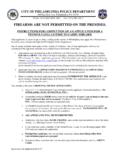
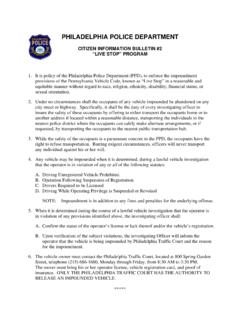
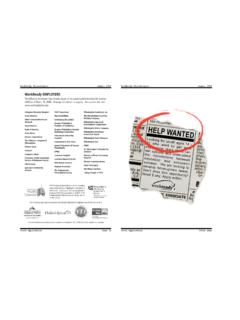

![[PSA] Philly: Classaction lawsuit brings changes in …](/cache/preview/1/4/c/8/8/d/5/c/thumb-14c88d5c5b2f1fee5e561fc7daceb397.jpg)
